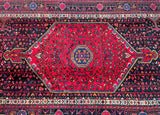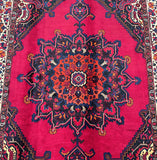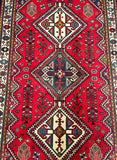Learn About Persian Rugs
Persian Rug Buyer's Guide
Learning about handmade rugs can be a difficult task. Many people who look to buy a rug would like to learn more about them.
Although there are several references in the holy books and ancient manuscripts to the efforts of mankind at weaving, there is no evidence that such references apply to the pile rug.
what little is known of the origin of the pile rug, according to the scientific and historical studies, we can assume the pile weaving had a nomadic origin.
Oldest rug found by well-known Russian archaeologist Professor S.J Rudenko in Siberia in 1949 called Pazyryk. This rug is believed to be crafted around 2500 BC in Azerbaijan (in north west Of Iran). That has made many expert believing that the origin of handmade rugs is Persia/Iran.
The characteristic and important factor that have made the carpets of Persia world-famous are their pleasant, varied and unique designs.
Each Persian carpet has a design of its own. so that thousands of fascinating designs can be seen in the whole range of Persian rugs, each being very beautiful and possessing perfect harmony.
Before talking about the variety of the design, we should mention that all designs can basically be categorized into three principal groups. All the motifs and figures which constitute the design are made from composition, contact, rotation and balance of the lines.
If the lines along their route make angles the design is in geometrical style. But if the lines in their course don't make angles, the design is classified in the curvilinear group. Should the lines of the design in some of their route makes angles and in the other makes roundish movement the design belongs to the stylized group.
Most Persian rugs are decorated with Medallion (Toranj) and corners. The medallion is always located in the center of the layout and the shape could be round, oval, rhomboid radial of different sizes which varies according to the taste and custom of the weavers.
All Persian rugs can be categorized into 2 main groups;
Tribal & Rural Designs
These designs have been influenced by old and noble Persian patterns that were created by the native carpet weavers. The simplicity of the life enjoyed by the weavers is reflected in the style of their productions. In spite of the patterns, which are not ordered and regular, the designs are still attractive and pleasant.
The designers have transferred these patterns from one district to another so that these designs can be found from the furthest east to furthest west of the country. Sometimes these designs are recognized by the name of the production zone Mazlaghan, Feroud or Vis or make take the name of the Chieftain such as Salar-Khani, Khal Mohammadi. Most tribal designs are in geometric and stylized pattern.
Urban/City Designs
The designs of urban carpets in comparison to tribal patterns are more elaborate and precise, therefore to craft them the weaver needs to use a template. Every compartment of this milli-metric sheet represents one knot of the carpet. City rug designs are more complex and usually belong to one of the following patterns:
Shah-Abbasi Design - King Abbasi
Arabesque (Eslimi)
Vase (Goldani)
Herati Design (Mahi-fish Pattern)
Tree Design
Botteh Design (Paisley Pattern)
Panel Design (Garden Design)
Historical Building Design
Portrait and Pictorial Design
Prayer Design
in next blog we will talk in depth about the design and provinces where tribal and urban rugs are made.
Hope this has given you a background about Persian rugs and if you like to purchase one please visit our store Persian rug warehouse WA
1/7 Pitt Way, Booragoon WA Perth 6154
or our online store www.shoparug.com.au









